It’s hard to believe it was only in March that we had the last letter from a Secretary of State which was all about post-HERA delivery, delivery, delivery across the OfS’s regulatory portfolio and beyond.
I’ll be honest though in admitting that Gavin Williamson’s latest note has rather taken some of us by surprise. Given everything else going on and the sheer freshness of the new Education team (apart from Chris Skidmore who had barely left before being invited back) it is perhaps more than a little unexpected that writing a letter to the sector would be a priority for anyone. Anyway, it’s arrived and this new one continues the brisk tone of Damien Hinds’ missive but with a tad more heft and ranging over areas including:
- TEF, TEF, TEF
- Admissions review and PQA
- Value for money
- Flexible study and accelerated degrees
- Unconditional offers (boo, hiss)
- Students as consumers
- Brexit (of course)
There has already been a detailed critique of this set of fun pointers on Wonkhe and our purpose here is only to cover the more superficial elements of the latest epistle.
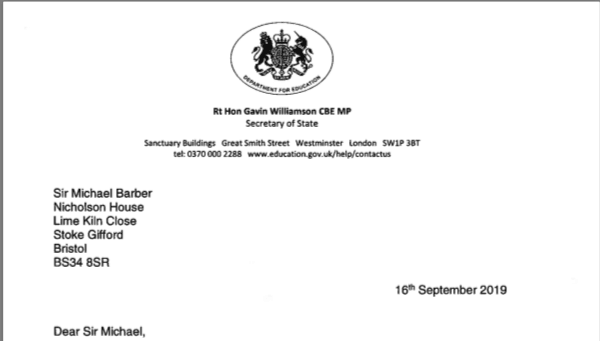
It’s all about me
Interestingly, for a letter about the formalities of regulation, this feels like a very personal statement from the Secretary of State. No fewer than 22 sentences begin with the first person singular and there are 16 other uses of ‘I’ in there too. It feels very upbeat in terms of its assessment of the post-HERA landscape and pleasure is expressed both about the robustness of the approach on Access and participation and the “rigorous decision-making” in relation to registration. My favourite bit though is the exhortation to the OfS to “exercise your powers boldly” and that phrase is actually in bold.
Anyway it continues the fine tradition of these Secretary of State letters and it is pleasing to note a new signature to our gallery. Previous signatures we have known and loved over the years:



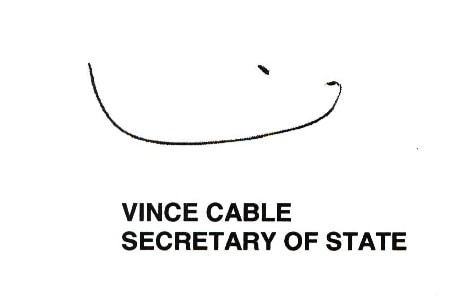
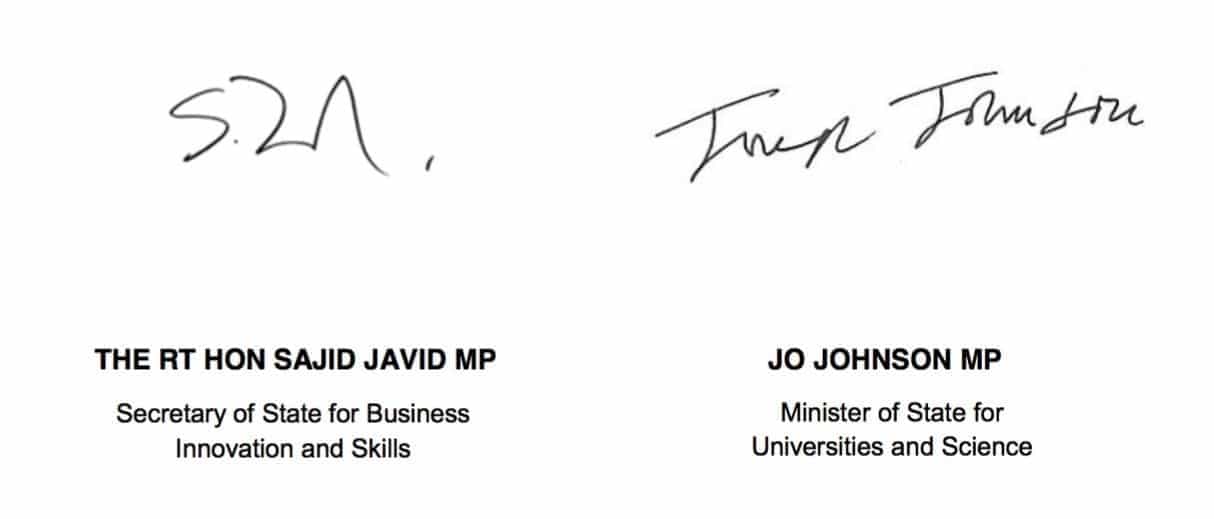
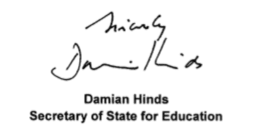
And here is the latest, rather stylish, addition:
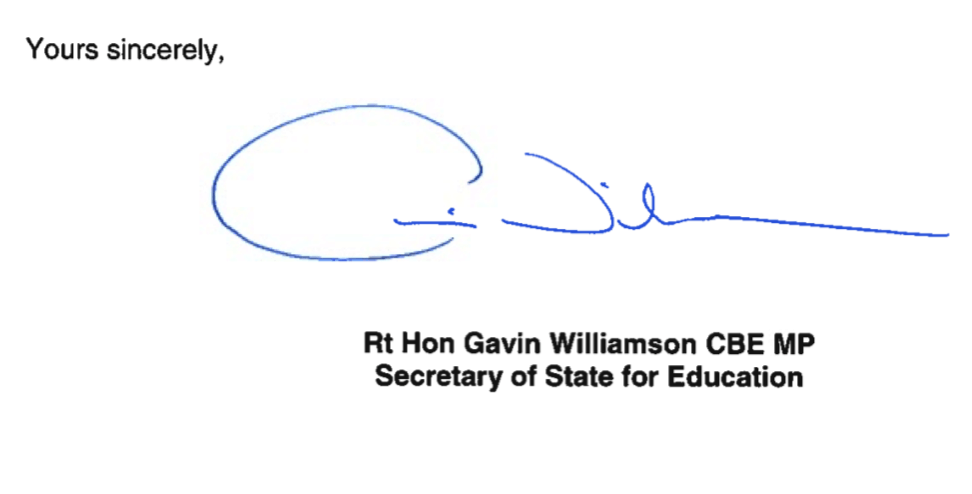
I think we can all agree it’s a novel one (although I still can’t quite see it as a fossilised fish as Johnny Rich has suggested) but still has some way to go to get anywhere close to the Vince Cable classic.
Short cuts
In terms of length, at 20 paragraphs it is among the shortest on record, equal to its predecessor from earlier this year and another back in 2004. The messages across its five fulsome pages are non-trivial though and, notwithstanding the fact that unlike last year and indeed most years it has no appendices, we should take the content very seriously indeed. The trend for letter length remains downward but no-one would argue I think that the significance of these letters has in any way diminished over time.
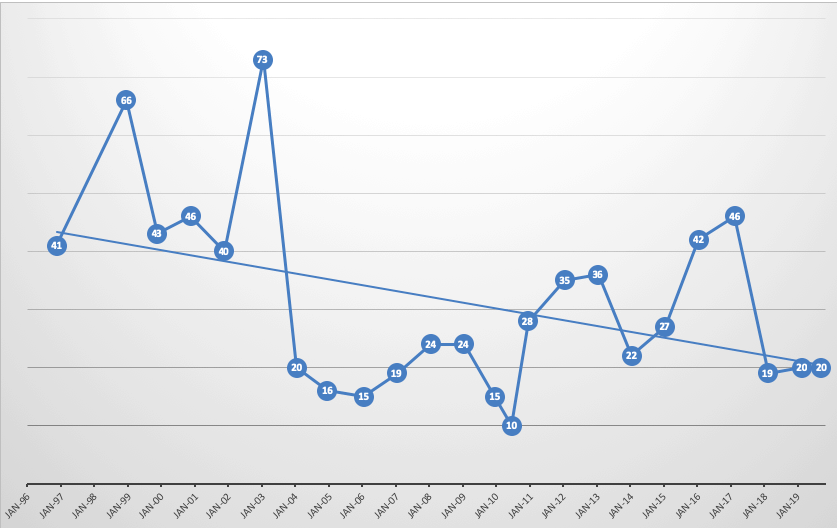
From our own many and varied correspondents
Just for reference, here is the commentary on all the previous correspondence. This saves all that tedious searching for stuff about grant letters in previous posts and you may find this especially handy if you are new to this niche area.
Things have really moved on over time and, although matters covered in letters are more directive to the regulator than in the past with clear instructions to deliver from the Secretary of State, they do at least seem to have the merit of greater brevity. This decidedly dubious summary of these letters is limited to English funding allocations, unfortunately. Whilst I’m sure the Welsh and Scottish funding councils and their Northern Ireland counterpart receive similar missives from their respective governments, it is beyond our scope to cover them here. Sorry about that.
So, let’s take the opportunity to look at nearly a quarter of a century of history of (English) higher education funding letters…
The length of funding letters has seen two peaks in the last couple of decades: January 2003’s letter was 73 paragraphs long and the December 1998 note ran to 66 paragraphs. The November 1999, November 2000 and December 2001 letters ranged from 40 to 46 paragraphs but the January 2004 letter and subsequent missives tend towards the more traditional brevity of only 15-25 paragraphs of instruction to HEFCE. A decline which matched the general trend of public funding for higher education perhaps until that is we got to 2016 when we shot back up to 42 paragraphs.
Just for completeness then here are some of the details about English Higher Education’s most exciting epistles:
- The first letter in this series is the last prepared under the previous Conservative government, way back in November 1996. This 41 paragraph note (signed by a Civil Servant) covers: linking funding to assessment of teaching quality, expanding part-time provision, the importance of closer links with employers, not wanting to see longer courses, a planned reduction in student numbers by 2,000 for the following year and keeping the participation rate at around 30%.
- The December 1998 letter is the first New Labour funding letter. At 66 paragraphs it is one of the longest in recent times and the last one to carry the name of a senior Civil Servant rather than the Secretary of State. Topics covered include sector spending, lifelong learning, increasing participation, maintaining quality and standards (a recurring theme down the years), widening access, promoting employability, research investment, capital spend, tuition fee arrangements and Year 2000 issues (we were all worried then).
- The November 1999 letter, 43 paragraphs long, provides David Blunkett with the opportunity to wax lyrical on the importance of maintaining quality and standards, increasing participation and employability, widening access, equal opportunities for HE staff, dealing with student complaints, new capital funding, pfi/ppp opportunities, research funding and HE pay.
- David Blunkett, in his November 2000 letter, which runs to a sprightly 46 paragraphs, makes some big points on widening participation as a key priority, business links and the e-university.
- In November 2001 Estelle Morris provides a neat 40 paragraph letter which gives lots of direction on widening participation, maintaining quality and standards, strengthening research, the importance of links with industry and communities, as well as something on the value of the e-Universities project (remember that?) and, last but not least, social inclusion.
- January 2003 represents the high water mark of recent funding letters: in 73 action packed paragraphs Charles Clarke, in his first outing as Secretary of State, is clearly keen to lead the way. The letter covers, among other things, improvement in research, expanded student numbers, foundation degrees, widening participation, improving teaching and learning and increased knowledge transfer. As if that were not enough we also have the establishment of the AHRC, the introduction of a new quality assurance regime but with reduced burdens for institutions (yeah, right), credit systems, FE partnerships, expanded student numbers and new investments in HE workforce development. A real blockbuster of a letter.
- The January 2004 message, again from Clarke, comes in at 20 paragraphs in just over 4 pages with reducing bureaucracy, building research and quality and standards and the establishment of Aimhigher as its central features.
- December 2004 brings a Christmas treat from everyone’s favourite Santa, Charles Clarke. With just 16 paragraphs and 4 pages of direction Clarke stresses the importance of maintaining the unit of funding for teaching, controlling student numbers and making efficiency gains.
- The January 2006 letter, a first and last offering from Ruth Kelly, comes in at a modest 15 paragraphs and 4 pages. No huge surprises in the text with employer-led provision, more widening participation, additional research and capital funding and a strong steer on reducing bureaucracy being the primary features. Additional points to note include equal opportunities for HE staff, efficiency gains, the new conditions which accompany the new tuition fees regime and reference to access agreements. What’s not to like here?
- January 2007’s is a punchy 19 paragraphs and merely five pages from Alan Johnson (his one and only letter). Despite the wordiness there isn’t a huge amount in here beyond employer engagement, growing foundation degrees and a lot on widening participation.
- January 2008: as with its successor letter this one is 24 paragraphs and 7 pages long (and note the online version on the HEFCE website is erroneously dated 18 Jan 2009). In this funding letter John Denham indicates that his priorities are increasing student numbers, developing employer part-funded provision, and widening participation. The letter also refers to encouraging HE to develop stronger links with schools and colleges, greater investment in research, the importance of STEM, a green development fund, closer measuring of performance, and the establishment of the fund-raising match-funding scheme.
- January 2009’s letter is 7 pages and 24 paragraphs long and in it John Denham seeks to encourage HE to support the economy through recession, wider engagement with business, promote employer-led provision, innovative ways to support business, promotion of STEM subjects and widening participation and extending fair access. Additionally, there is the confirmation of the ‘university challenge’ with 20 new HE centres to be established, emphasis on the maintenance of quality and standards, plans for continuing to reduce regulation, commitment to dual support as well as the development of REF, steps to tackle climate change and bearing down on over-recruitment by institutions.
- The December 2009 letter from Lord Mandelson, the last of the New Labour era, comes in at just 15 paragraphs. This short note follows up on Higher Ambitions (which, in case you had forgotten, “sets out a course for how universities can remain world class, providing the nation with the high level skills needed to remain competitive, while continuing to attract the brightest students and researchers”) and also covers the Economic Challenge Investment Fund, wider and fairer access to HE, increasing the variety of undergraduate provision, new funding incentives to deliver higher level skills, developing REF, new developments in quality assurance including the publication of a standard set of information for students, engaging with communities and penalizing institutions which over-recruit students.
- June 2010 sees the first funding letter from the new coalition government: Cable and Willetts give us 10 brief paragraphs covering initial savings, efficiencies and cuts but also 10,000 extra places (but with strings). It was the shortest funding letter to the Council in at least 14 years and undercuts all letters under the previous government by some way. It was also the first outing for Vince Cable’s smiley signature.
- There was a bit of a steep change with the 2013 letter. Not only does it offer even more directions to HEFCE, at 36 paragraphs and eight pages it is the second longest of the four to date issued by the coalition Secretary of State and the Minister and confirms a return to the sterling epistolary efforts made by the previous government.
- More recently in 2014 it was back to a more perfunctory 22 paragraphs, excluding the covering letter, or 26 if you include the substantive comments in the letter.
- 2015 saw the final letter of the coalition era – a rather snappy 27 paragraphs spread over five pages of a 12 page package. But, as with previous years, there was quite a lot of the self-congratulation contained in a three page covering letter.
- At 42 paragraphs the 2016 note was significantly longer than recent examples of this kind of missive and was the longest since the beginning of 2003. It almost takes us back to the 41 paragraphs of the opening one of the series in 1996.
- And then we have the final one, the last letter ever to HEFCE. At 46 paragraphs it was significantly longer than the average of just under 32 paragraphs and in fact came in as equal third longest of all time.
- 2018 then brought the first letter of the new era which confirmed this was the ‘first annual statement of Government priorities for the OfS’ under ‘the new regime’ before talking about the need for the new agency to demonstrate ambition, to champion students and to operate as a new market regulator with a new mission. At 19 paragraphs it equals the fourth shortest of all time. The trend is still downwards and the upturn of the last few years has now been reversed. The missive itself is barely 4 pages long but includes a bonus 15 pages of appendices, 9 pages of which are the detailed ‘deliverables’.
- The first letter of 2019, at only 20 paragraphs was among the shortest on record. Unlike 2018 it had only the briefest of attachments, two annexes over two pages, the first being a mere four paragraphs on funding and the second simply a table highlighting superseded matters from previous guidance.
Until the next one then…but let’s hope in future there aren’t more than one or two a year because we really can’t cope with much more of this stuff.













With reference to whether Gavin Williamson’s signature looks like a fossilised fish, I give you exhibit A: https://twitter.com/JohnnySRich/status/1173576912595300352